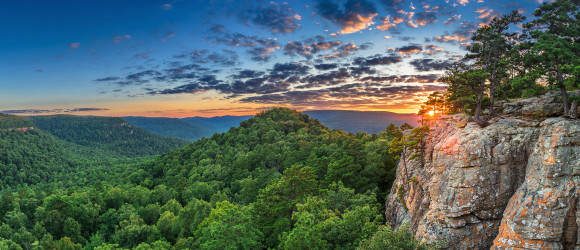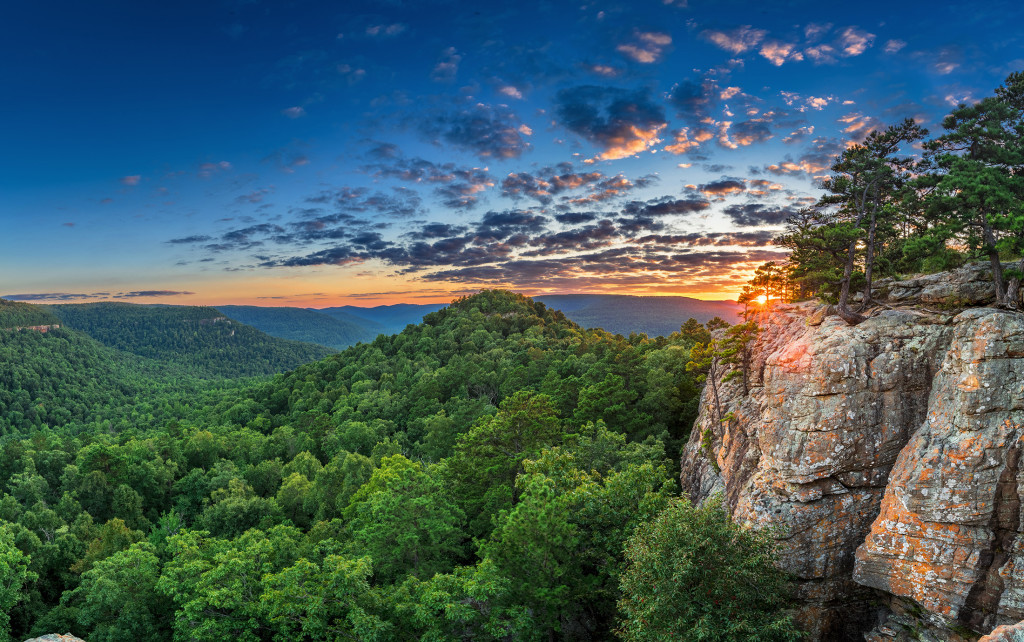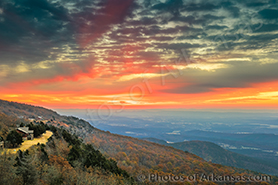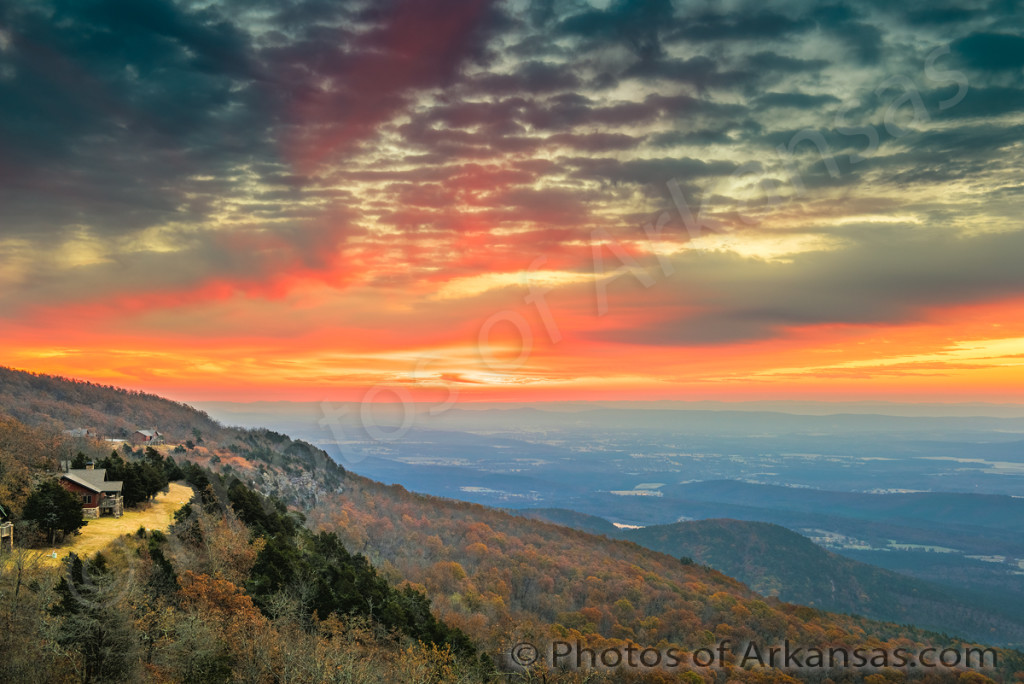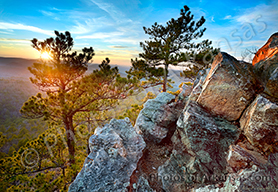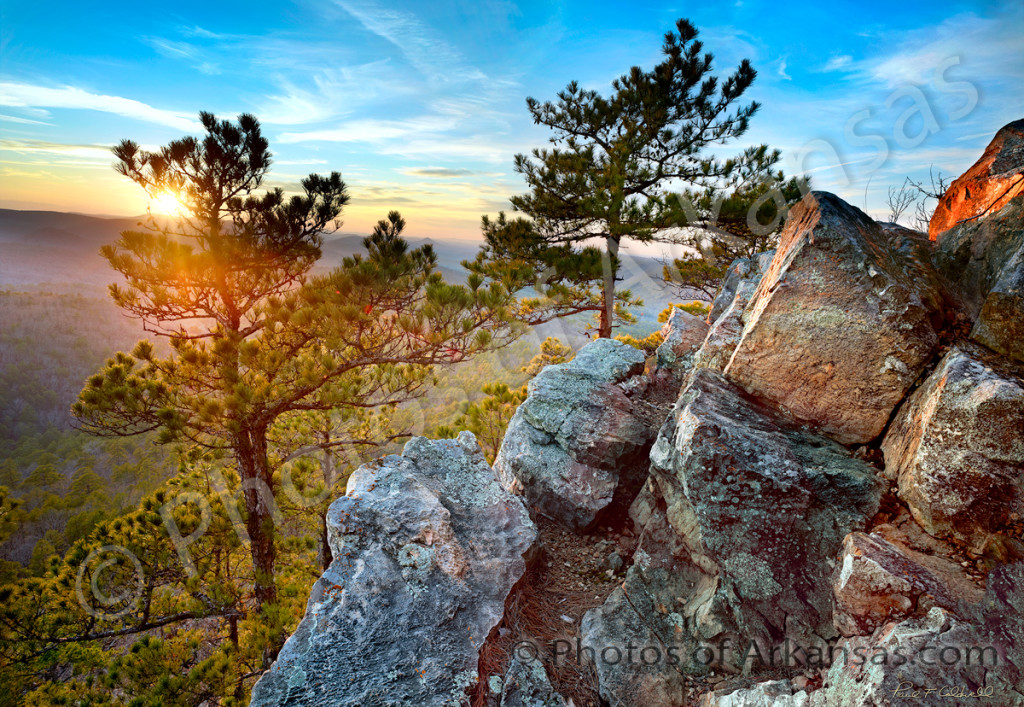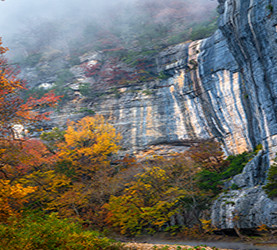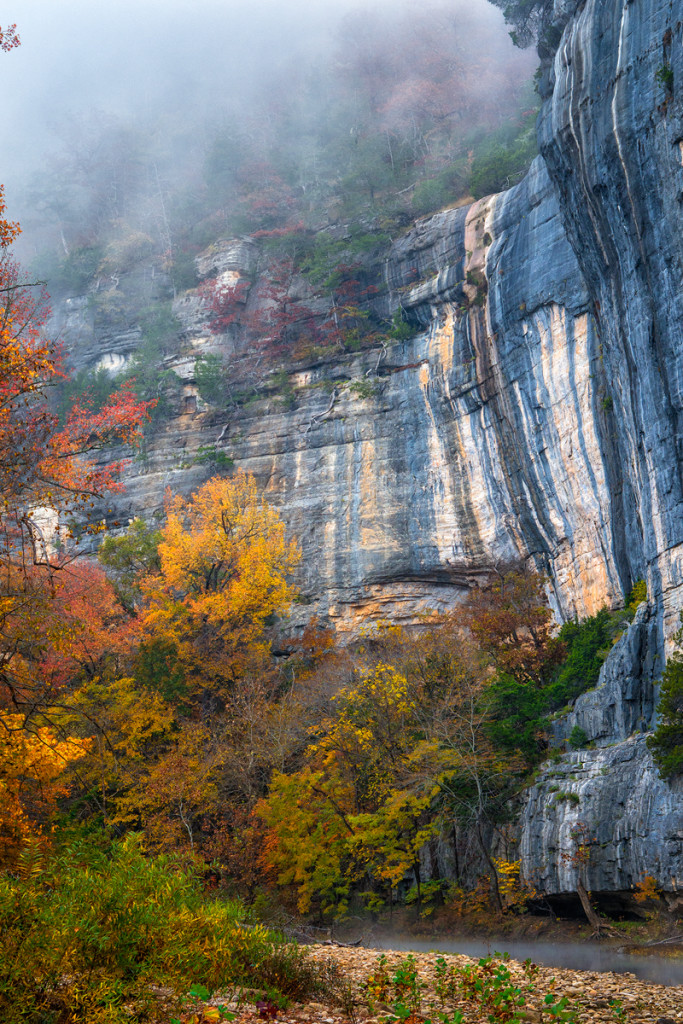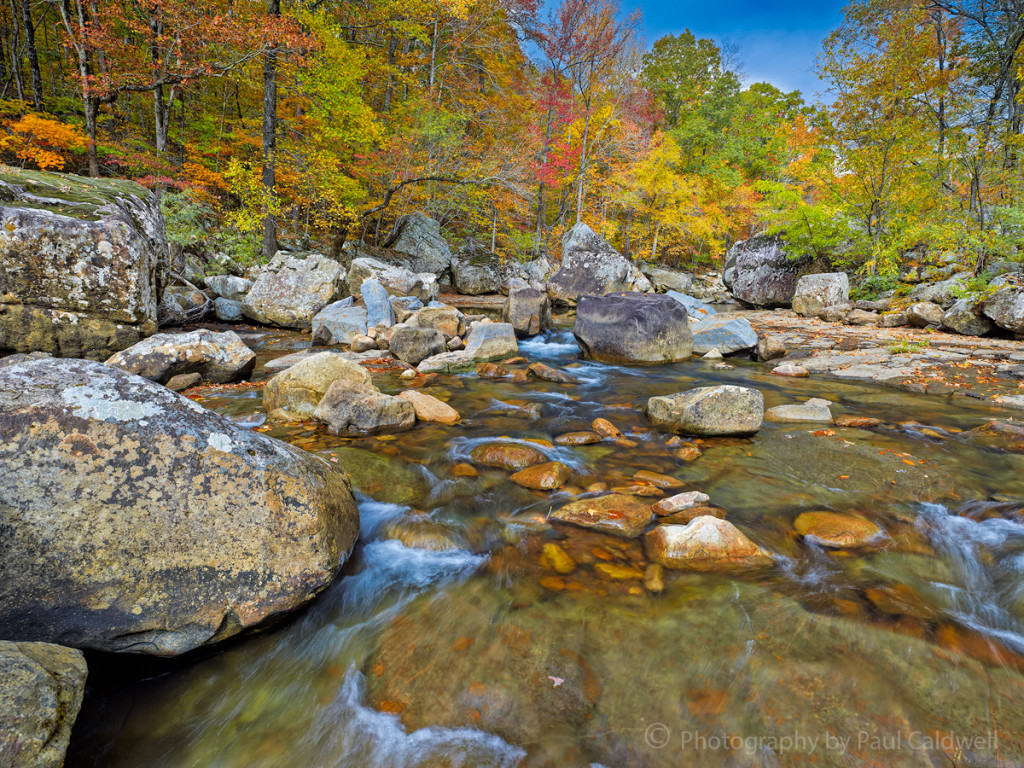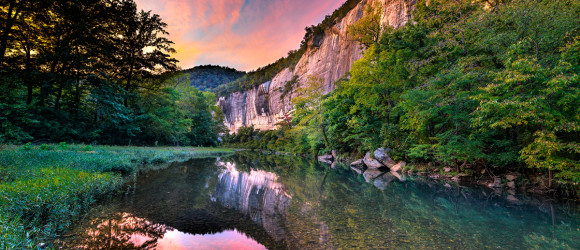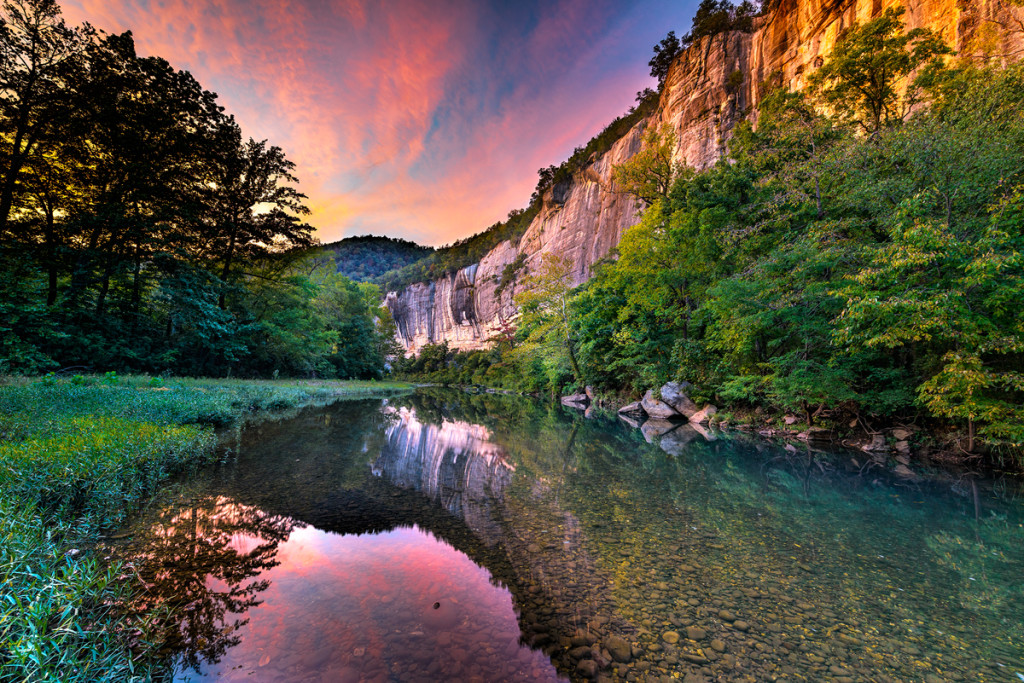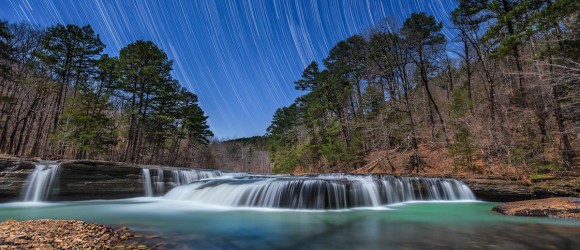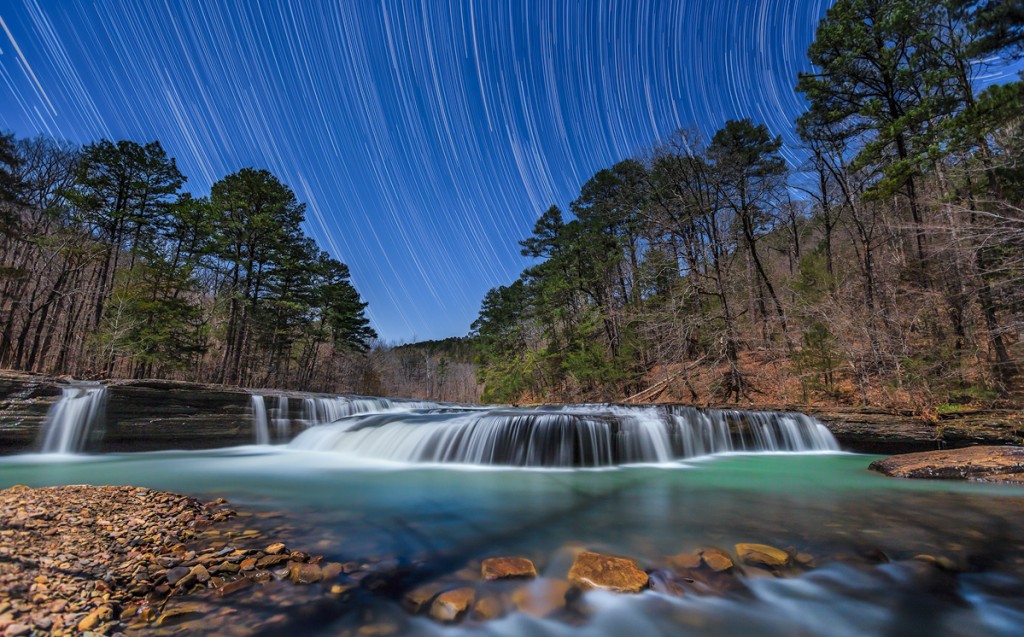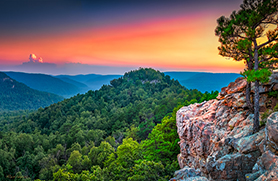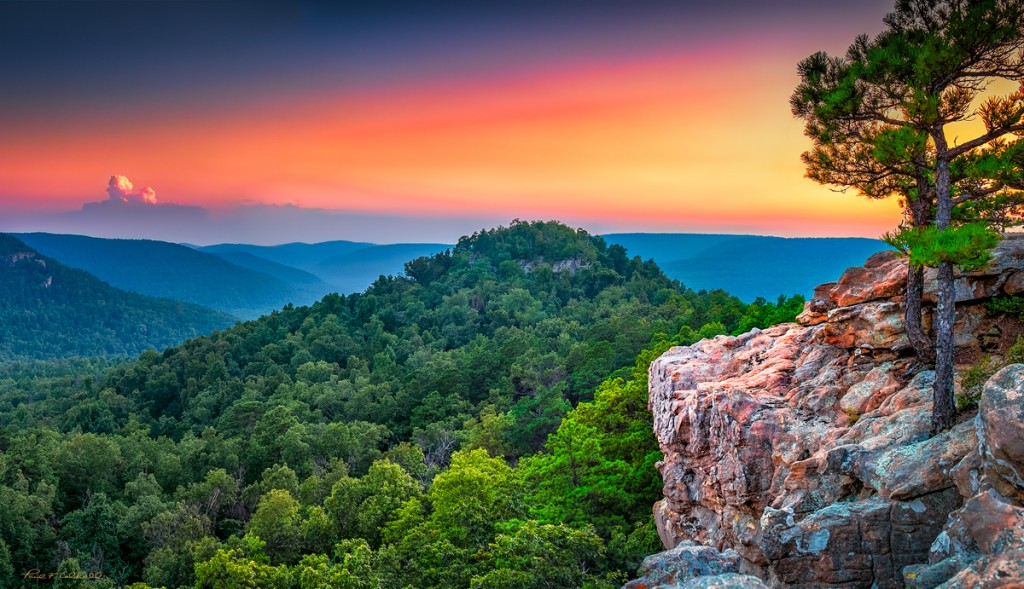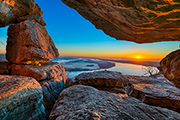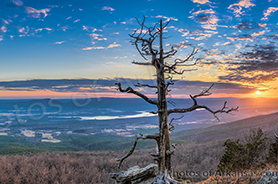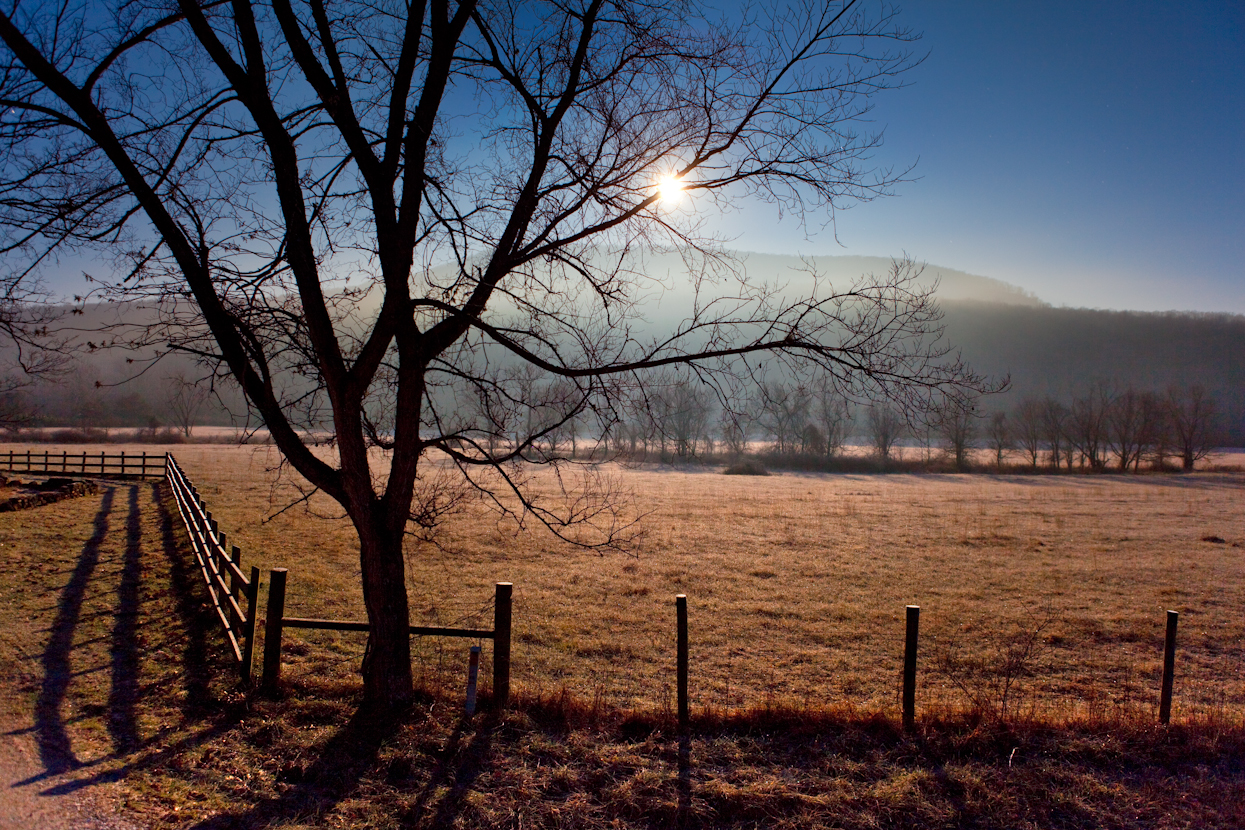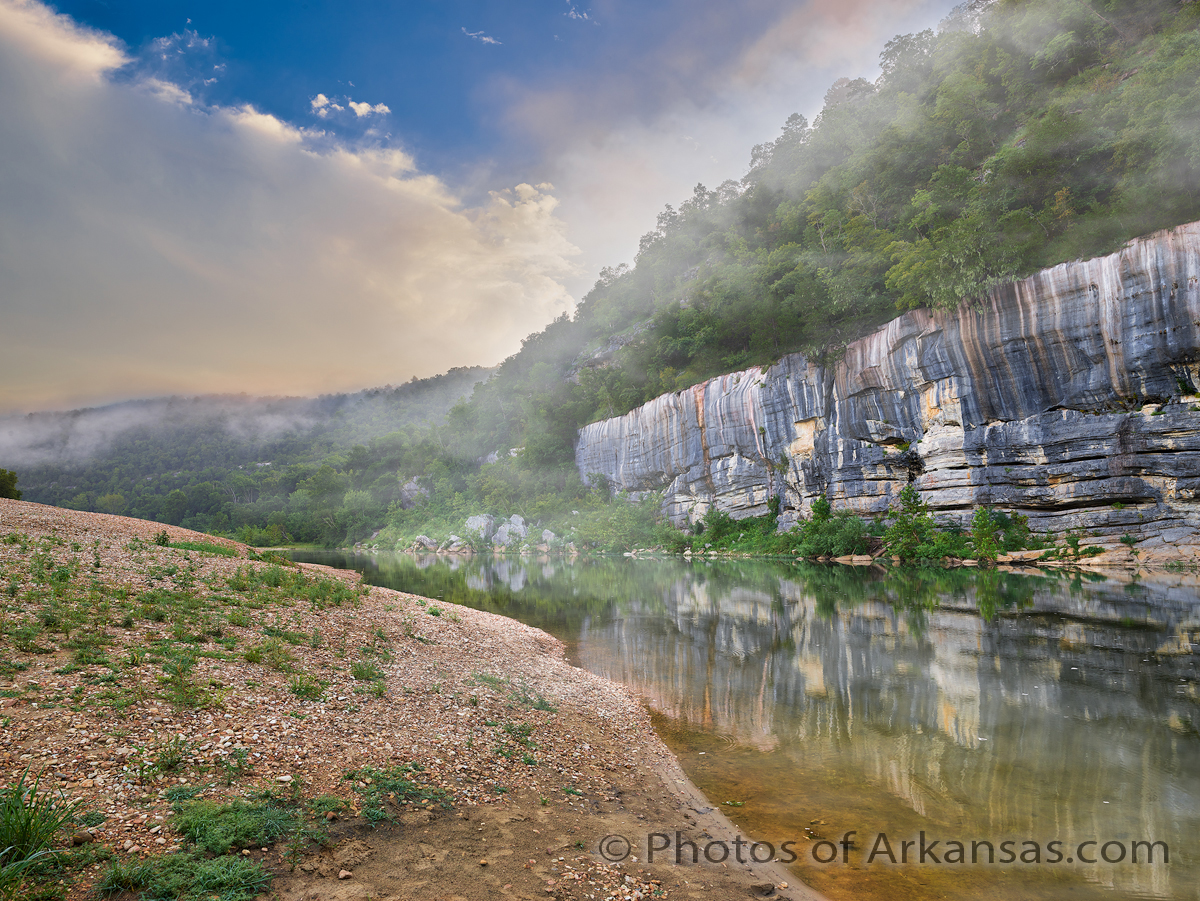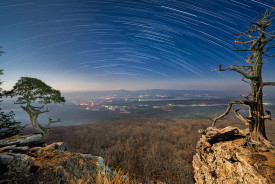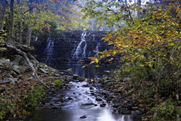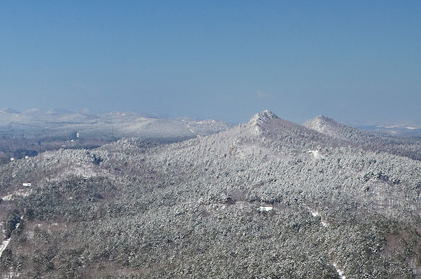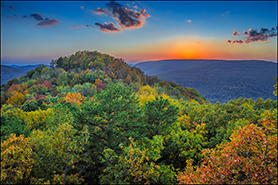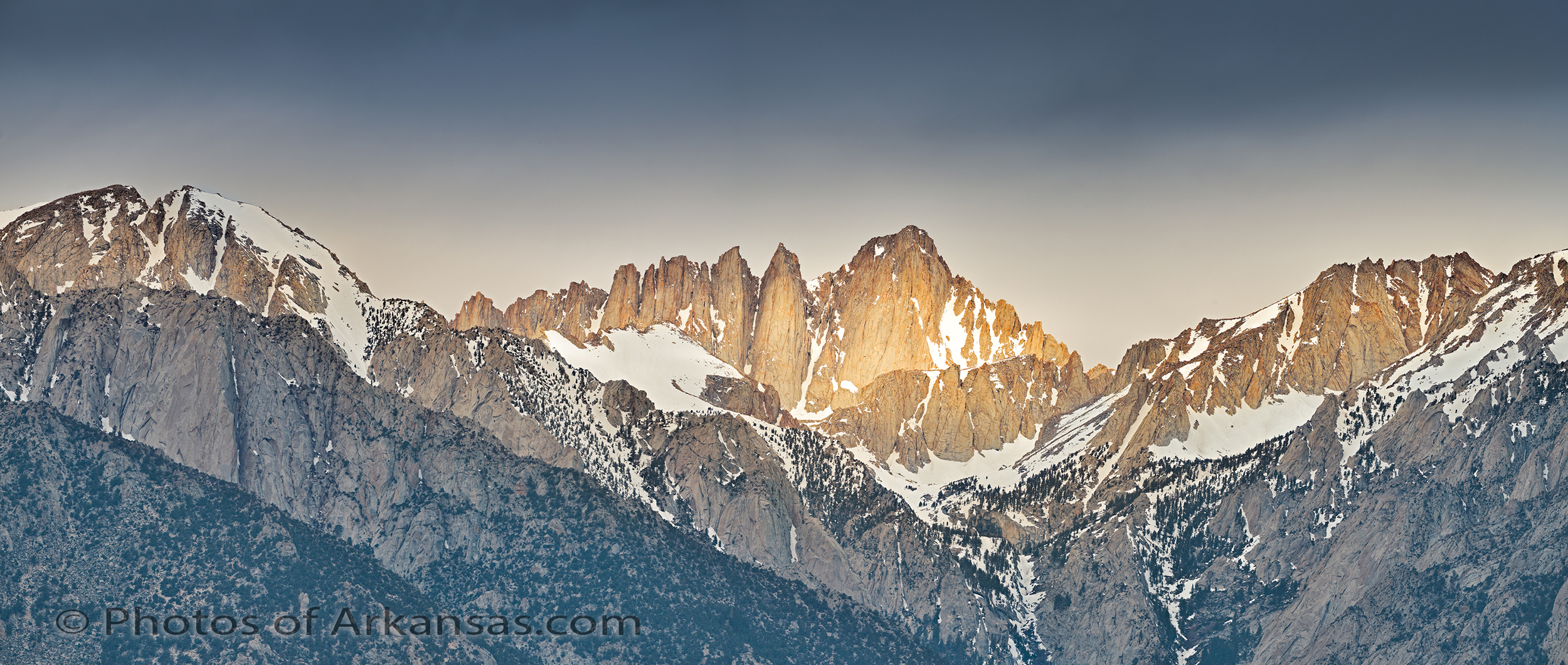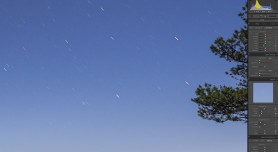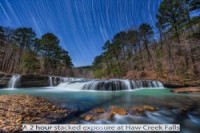09_10_16 Featured Arkansas Landscape Photography–Sunset from Sam’s Throne
Taken with a Pentax K1 in three vertical segments of 4 exposures each, LR used for HDR conversion to 3 vertical segemnts, Stitched in Lightroom into single 3 part panorama, ISO 100, F11 Pentax 15-30mm Lens @ 17mm.
In the late summertime of September, the Arkansas skies can surprise you. Many times you will find a pure blue sky about 1 hour before sunset, only to see some light cloud cover roll right as the sun sets. On this evening, I was able to catch some of this at Sam’s Throne. I had hoped to have clear skies as I was going to stay for a while after dark and work the Milky Way with the Pentax Astrotracer feature, but the sunset was a added bonus for sure.
Sam’s Throne is one of the premier climbing spots in Arkansas due to the bluffs that run for over 1 mile. The rock is a type of sand stone and and during the sunset will take on an orange color. The rocks are also covered with a bright orange lichen, one that I have really only found in this part of Arkansas. So at the times of bright and intense light, the rock of the bluffs can really stand out. I like to work from a spot where you can catch both the true throne (the smaller peak in the center of the image) and pick up the bluff line. During the late summertime the sun will set just off the bluff through the trees and can add a wonderful effect as it will accent the pines at the top of the bluff line.
This photograph, is quite a composition as it was taken in 12 frames, 4 from each station in a short panorama. I then blended each segment with Lightroom’s HDR tool into a 3 dng files, that were then combined into a 3 part panorama. This allowed me to capture both the brightest highlights in the shot and keep the noise out of my shadows. The green of the trees was just perfect on this evening, just a bit of yellow starting to show up in the tops. There were a few trees already starting to go into a full color display, but these were more towards the top of the bluff.
You can pick any of hundreds of spots to work at Sam’s. In this shot, you can see on the left side the same bluff line as it has worked around the hillside. I sometimes like to work from that spot also as you can still capture the sunset and you have a different perspective of Sam’s.
It takes about 2.5 hours to get to this part of Arkansas from Little Rock, and the drive north from Russellville is well worth it, especially in the Spring and Fall when the trees take on very unique colors.
Featured Arkansas Landscape Photography–October sunrise on Mt Magazine
- At March 25, 2016
- By paul
- In Featured Arkansas Photography
 0
0
PLEASE NOTE: All of the photography of this website is the property of www.photosofarkansas.com and is copy right protected. Do not copy any of the images on this site to paste on Facebook, Pintrest, or any other website without the permission of Paul Caldwell. Years of time have gone into capturing these photographs, please respect that. I do not take copy right infringement lightly. If you have a need to display any of my work on your site ASK me before you Copy & Paste.
Taken with a Nikon D810 and 14-24 Lens @ 14mm and F 5.6 ISO 250 exposure bracketed in 3 frames
On Mt Magazine, the view in late October back to the east can provide some amazing sunrises. The sun will rise right out in the center of the frame and when you have clouds the light can be fantastic. In this shot, I was on the 3rd floor of the lodge, but you can work from any floor. All the rooms on the lodge open out to the back side and have a southward facing view. Mt Magazine is the “border” of the end of the Ozark mountains, as all the mountains to the south are in the Ouachita Mountains. So you get a excellent view of the beginning of the Ouachita chain that runs from here to the southwest corner of Arkansas. In the view looking back to the east, you can see Flatside Pinnacle way off in the distance also. Flatside is 1,500 feet tall and is a great photographic area also.
Later in the spring and summer the sun will move back to the left and will rise out of view, so the best times to catch a sunrise, is October through early February. In 2015, the fall colors in Arkansas sucked, yes, they were that back. Mt Magazine tends to have a pretty good display even in the years like 2015 and I guess this is due to micro climate that Mt Magazine has, being 2,700 feet tall. But what made this shot were the clouds that came across the sky right as the sun came up. The sun is in the dead center of this shot, but is filtered by the band of clouds that are right on the horizon, but these same clouds allowed the light to reflect upwards and just popped the clouds towards the top of the frame.
I used ISO 250 on this shot as there was considerable wind blowing I wanted to start my exposure stack with a higher shutter speed. The Nikon D810 does a good job here, not as well as it would have at base ISO of 64, but I was still able to stop the motion of the trees and get the shot. The camera was mounted to tripod so alignment was not an issue. I used the HDR feature of Adobe Lightroom to merge the 3 exposures and Lightroom did a very good job on this shot. In this shot you can see the rock bluffs of Mt Magazine and then one row of the cabins that can be rented. There is really no way to get this shot without also getting the cabins in the view, so I just include them. Off in the distance you can see a couple of the rolling ridges that create the Ouachita mountains.
02/14/16 Featured Arkansas Landscape Photography–Sunset from the summit of Flatside Pinnacle
PLEASE NOTE: All of the photography of this website is the property of www.photosofarkansas.com and is copy right protected. Do not copy any of the images on this site to paste on Facebook, Pintrest, or any other website without the permission of Paul Caldwell. Years of time have gone into capturing these photographs, please respect that. I do not take copy right infringement lightly. If you have a need to display any of my work on your site ASK me before you Copy & Paste.
Taken with a Phase One IQ160 Medium Format Back and Arca rm3di/28mm Rodenstock Lens, image was captured in a bracketed series of exposures.
I have featured this image many times, but it’s still one of my favorites. I took this shot in January 2011 with a “tech” camera an Arca rm3di, with a Rodenstock 28mm lens. This view has since been ruined by graffiti, which was painted all over the rocks. I have slowly tried to removed it over the past 2 years, and have made some progress, however to the assholes that did it, **uk you.
Flatside Pinnacle is the key point in the Flatside Wilderness, and is right in the middle of the Quachita mountains. Looking in the shot between the two pine trees you can see Forked Mountain off in the western distance. Towards the middle of summer, you can catch the sun setting over the top of Forked Mountain. Flatside itself is around 1,500 feet tall, which make it taller than both Mt. Nebo, (near Russellville) and Petit Jean Mountain. The good news is that you don’t have hike very far to get to the summit as a road takes you almost all the way to summit. The Ouachita trail comes very close to Flatside also. The view from the summit has to be one of the best in Arkansas. Here looking to the west you can see Forked Mountain, and off to the right, Mt. Nebo, Spring Mountain, and the grandest of all Mt. Magazine, which is over 2,700 feet tall.
Flatside is great spot to catch a sunset, however if you want to get the best light try to get there before 11:00 am as after that you will be shooting into the sun. If there are some clouds, you may still get away with a great shot. Take a lunch and sit out on the rocks and enjoy the day.
11/18/15 Featured Arkansas Landscape Photography–Foggy view of Roark Bluff
Taken with a Nikon D810, Nikon 24-120mm Lens, hand held @ 320iso for 1/100 of second, F 5.6
When I think of the Buffalo River, I tend to think about Roark Bluff and the beauty around that part of the river. Here you have two of the largest bluffs on the river, Roark and Bee both of which are well over 300 to 400 yards long. Each bluff has a unique character to it and the colors of the limestone comes alive in the early morning. At this time you have the valley totally fogged in. The fog will last for a while after sunrise and the best time to photograph the mornings is when the sun has started pop through the fog and adds a very unique light to the scene. Now add fall colors you have a real prime setting for sure.
On this morning, I was amazed to have the entire beach to myself, and I will take that when I can get it. It was a Sunday morning and the colors on the top of Roark Bluff had already turned brown, however there was still excellent color along the river. The top of the bluff seems to be mainly hickoy and maple, but on the riverbank there is a lot more variety. Here you will find oak, sweetgum, maple and gums. The display this morning was perfect. I had a tall gum tree on the upper left of the frame still showing the brillant yellows and reds, and across the river was another gum tree, but in pure yellow. In the foreground the river birch is starting to turn from green to yellow so overall it was a nice setting. I framed the shot with just a bit of the fog on the top of the shot. I still wanted to be able to see through the fog to make out the colors along the top of the bluff.
Roark is a great place to drive and spend the entire day. You can watch the sun move across the valley and enjoyed varied shooting situations during the day. Roark is one of my favorite spots for night photography, either star trail work or the milky way.
11/15/15 Featured Arkansas Landscape Photography–Autumn afternoon at Pinnacle Mountain State Park
Taken with a Nikon D800e, Nikkor 24-120 lens @ F8, ISO 100. Image taken in 3 parts and stitched together in PtGui and Photoshop.
This was just one of those days. I had been out a few times previously, but the conditions did not equal this afternoon. You have to wait until around 2:00 pm to get this shot as you want the sun over the back of your shoulder. The light was perfect and Little Rock had a much better fall than other locations in Arkansas. But the clouds, oh the clouds. They started out as just some small swirls but as I continued to shoot they grew into this massive line that was turned upwards. To get this type of a panorama, even with a 36Mp camera, I knew I would need to stitch. However since my subject (main subject) was all off in the distance, I did not worry about a tripod, or setting my nodal point. I didn’t need to, just aimed and shot. I was using the Nikon 24-120, and was in the 90mm focal range. The colors that afternoon were perfect also, but I did add a circular polarizer to help pop them some more and cut the glare. You can clearly see the exposed part of the trail heading to the summit. Pinnacle to me is best photographed from below as the view from the top is impressive, but surround by homes, roads and the like.
To make this image happen, I first converted the raw files in Adobe Lightroom, then opened them up in PtGui, (a panoramic stitching software). The image came together perfectly and at first I thought I was done. But on closer inspection, I found that during the stitching I had allow for blur on the center image. It was only on the right edge and looked like a VR user error. VR is Nikon’s vibration reduction that is built into some of their lenses. If you are panning you have to be care with VR as you can confuse the system and it will not be totally finished. When you take a picture like that the blur looks more like a rolling issue as some of the file will be fine but usually towards one edge you will pick up some vibration induced blur.
So I had to manually go back to another image and pull that one part back to this stitch. It was not as hard as I thought it would be and the overall came out fine.
Early fall morning along Richland Creek–05/29/15 Featured Arkansas Landscape Photography
- At May 29, 2015
- By paul
- In Featured Arkansas Photography
 0
0
Taken with a Phase One IQ160 and Arca rm3di camera and Rodenstock 28mm lens @ iso 50 for 1/2 second exposure.
I am a huge fan of Richland Creek, having spent at least the last 20 years or so exploring it’s vast reaches. I was lucky enough to Kayak this creek for over 10 years as that one of the best ways to get to know a creek. Richland (the name comes from the fact that the mouth of Richland near Woolum Ford on the Buffalo was excellent farming land) has some beautiful features throughout it’s length as it moves towards the Buffalo, but by far the best scenery is found in the 5 miles of the creek above Richland campground. This shot was taken on a fall morning and the sun was popping back and forth between the clouds. I was setup and waited on the best light for at least 20 minutes and only got about 2 minutes before the next bank of clouds rolled in. The level of water in the creek on this day was low but in many respects this is an excellent level for photography as you can safely stand in the middle of the creek for the best vantage points. One aspect of creek photography, if you don’t plan on getting wet, don’t bother.
This spot is directly below one of the larger rapids on Richland called, Shaw’s Folly. In this shot, look for the large rock on the upper right which is about the size of a small house. This marks the end of the rapid and all of the creek in the picture is just the run out. But in this shot you can see why I love Richland as it’s just full of huge rocks and each one has it’s own unique shape and color. The water was gin clear this day so I was able to feature some of the bottom of the creek by using a polarizer to cut the glare.
October Sunset on the Buffalo River at Roark Bluff–02/24/15 Featured Arkansas Photography
Taken with an Nikon D810, Nikon 14-24 lens @ 14mm F8, iso 64, 1/3 of a second in a single exposure.
This is one of those images that you have to work on a while, then come back to and work it some more and then again and again. I took this shot while on a sunset/night shoot with Chris Kennedy from Russellville. We were just setting up for the night, on 10/04/14, knowing that we were way to early for the maximum fall color display, however I wanted to work with the best moonlight for later on that evening. You can barely see some pretty strong color up on top of the bluff, and the trees on the right bank were showing a bit of yellow. I have been to this spot hundreds of times and sunsets here are hit and miss. I have one other shot that is similar taken over 2 years ago, where it was also dead calm and the clouds started to get illuminated by the sun.
On this evening it started out with nothing, then as the sun crept down the left side of the frame, a bunch of high clouds rolled in. I started immediately for a spot further down the river, where I know one of the best reflections can be taken from. You have to watch this spot when certain photographers are “teaching” as they will all line up here and block the river. However it was still a bit early for this particular photographer and his minions to flock down the river. Chris decided to stay up higher and go for a different shot, but I wanted the full bluff reflection. If there is no wind on the river the reflection here will be as sharp as looking in a mirror, which on this evening it was.
As the sun set, the light on the bluff and clouds just got better. The sun hit the far right side of the bluff and turned it yellow and the afterglow on the middle of the bluff took on a wonderful rose color. The fact that there was no wind offered one great reflection of both the bluff and the clouds. I started to shoot this series with the Nikon D810, and really was not paying much attention to my histogram. I was a bit more concerned about the trees and such in the foreground and forgot to look to see if I was blowing out the sky. I was right on the line of 255:255:255: as it turned out, but somehow manged to get 5 or 6 frames that were no blown. I really attribute this to the Nikon D810’s amazing range of dynamic range at the base iso of 64. Normally I would have setup a bracketed series of exposures, but the light was changing so fast, I just shot as fast as I could and manually tried to change the bracketing but I did not really change the exposure enough to really protect the sky. The D810 is bit more tricky on highlight recovery than the D800 was and I was still shooting with the D800 mindset.
I knew from memory just how dramatic the light was that evening, so I worked this image up about 3 different times and attached different aspects of it each time. One time the sky, then the bluff, then the shadows on both banks. My main goal was to capture the amazing play of light on the bluff, from the rose color to the bright golden color on the far right. I then had to work up the reflections and make sure that the colors matched.
This shot was totally worked up in Lightroom and Photoshop. I ended up going back and forth several times before I got the image the way I wanted it. I then tweaked the colors with Topaz Clarity, which is final step I use now on pretty much all my shots.
Overall, the end result is shown here and once again it shows just how beautiful the Buffalo River and it’s bluffs can be.
09/28/14 Featured Arkansas Landscape Photography–Midnight at Haw Creek Falls
Taken with a Canon 6D, Canon 16-35 lens, at F4, iso 400, 2 hour time lapse photograph. This photograph was obtained by taking a series of 2 minute exposures from 10:00 pm to 12:15 am at Haw Creek Falls in the Arkansas Ozarks. I used a Canon 6D and a focal length of 18mm to take a series of 2 1/2 minute exposures. Each exposure was taken as raw file and developed in Lightroom, then I stacked them in Adobe Photoshop to capture only the motion of the earth over 2 hours which created the “trails. The blue color to the sky is from the moon, which was just a bit past 1/2 waxing. The moon adds both excellent ambient illumination to the night sky, giving it a blue hue, and also greatly adds to the landscape portion of the photograph. There was no light painting used on this photography, it’s all the light from the moon. I prefer this greatly over using artificial lighting, by painting as the moon just works better. You can read more about this technique in an article I wrote: Stacking for better nighttime photography. This photograph was taken in April of 2014, and spring was very late this year as can be seen in the trees on both banks of the creek.
I been working for a shot like this from Haw Creek for over 3 years. Catching the conditions all together can be harder than you think. You need a good flow of water, but not too much, as was present in March. The moon needs to be waxing for this shot, not waning or you will be up way to late waiting on the moon to appear. A clear sky is needed, with no clouds if possible and this does not always work out, as over 2 hours it’s quite common to see a front blow in. Also it work best if there is little to no wind. But since I am stacking I usually can find one of the stacks that has less wind noise than the rest.
This shot has it all, as you have great water, running over most of the ledge, and excellent play of shadows on the foreground. I am looking to the northwest, you can barely see where the north star is up in the upper right corner of the shot. It’s not very easy to get a good shot of the falls and the north star from below the drop, but the wide angle lens I was using did grab a nice portion of the sky. Of all the photograph I work with, nighttime stacking takes by far the greatest amount of time, both in the capture of the images and post processing, however I love the look of what I can create.
06/13/14 Featured Arkansas Photography–Sunset and Distant Thunderstorm at Sam’s Throne
- At June 13, 2014
- By paul
- In Featured Arkansas Photography
 1
1
Taken with a Fuji X-E1 18-55 lens @ 18mm and F11 iso 200, image taken in 3 vertical series and converted into 1 horizontal image. I can never get enough of the vista from Sam’s Throne in Searcy County, Arkansas. This spot is surround by red/yellow sandstone bluffs that really will catch the setting sun. In this view, the sun had already dropped below the hills in the distance, however there was still plenty of light available. This day had started out with a cloudy and overcast sky, which as the day wore on, started to open up. By sundown only one large storm was still visible way off in the distance and the light hitting it really made the thunderheads pop. One of the most beautiful things about Sam’s Throne is the way the hills overlap off into the distance. This is the valley of Big Creek which is one of the largest tributaries of the Buffalo National River. The bluffs around Sam’s Throne are a favorite for rock climbers in the state. It’s a great place to spend the day. I took this shot my my camera in the vertical orientation in 3 segments, and then stitched them into 1 image that is in the landscape orientation. This allowed me to have much greater overall resolution.
10/18/13 Featured Arkansas Photography–Sunrise through the rocks on Petit Jean Mountain
Taken with a Nikon D800, Nikon 14-24 lens @ 14mm, F 8, iso 100, exposure bracketed in 4 series. Petit Jean State Park (which was able to stay open throughout all of the stupid government shutdown) has some wonderful places for sunrise/sunset photography. The mountain has one long section that runs along the length of the Arkansas River and the eastern most end has a great view of the river as it turns due west towards the city of Morrellton. During certain times of the year, you can catch the sun where it will briefly (for about 5 minutes) totally illuminate the rocks below the summit. I have worked this spot hundreds of times over the year, but didn’t realize that this scene was possible until last December. You can also see on the large rock to the left what appears to be the profile of a face. On this day there was just a small amount of fog in the valley off in the distance and when the sun popped up over the horizon, the glow was amazing. I took this photograph with a Nikon D800 with 4 exposure brackets but due to the amazing dynamic range of the D800 at iso 100, I only ended up need 2.

